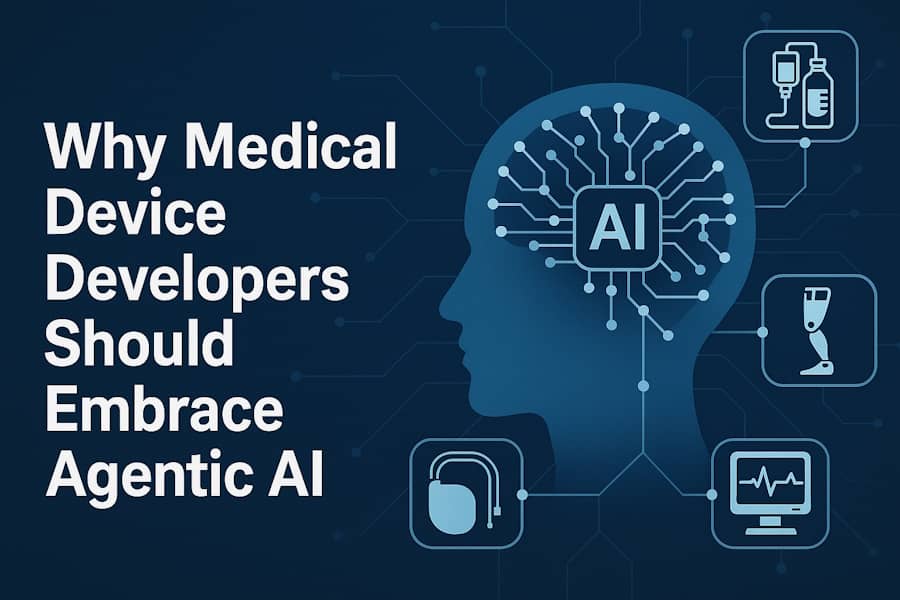The pace of medical device innovation has always been dictated by a combination of engineering ingenuity, clinical rigor, and regulatory scrutiny. In recent years, however, the complexity of new devices and systems has outpaced the capabilities of traditional design methodologies. Developers are under increasing pressure to create smarter, safer, and more personalized products within tighter timelines and cost constraints. In this environment, a rethinking of how development processes are structured is no longer optional—it is imperative.
At the heart of this reimagining lies a new generation of artificial intelligence known as agentic AI. Unlike conventional AI, which typically functions as a passive tool responding to direct inputs, agentic AI acts autonomously to achieve defined goals within complex systems. This makes it uniquely suited for the multilayered challenges of MedTech, where regulatory, clinical, and engineering considerations must be reconciled in real time. The agentic model can reduce the number of iterative cycles, identify design blind spots, and optimize system-level tradeoffs that often elude even experienced human teams.
The result is a transformative shift in how medical device development is approached—from a reactive, sequential process to a proactive, collaborative one. Agentic AI doesn’t merely accelerate workflows; it changes the very fabric of product development. Teams no longer rely solely on static models or fragmented tools. Instead, they interact with intelligent agents that understand context, anticipate downstream challenges, and autonomously act to mitigate risks. This reorientation has profound implications for the future of medical innovation.
The Power of Autonomy in Engineering Systems
One of the primary benefits of agentic AI is its ability to act independently within defined parameters to achieve specific objectives. This autonomy is not about removing human input, but about amplifying human decision-making through intelligent, goal-directed behavior. In the context of medical device design, where systems interact with human physiology and clinical workflows, autonomous agents can perform rapid simulations, evaluate design tradeoffs, and even recommend actionable modifications in real time.
Unlike traditional AI systems that depend heavily on supervised learning and fixed datasets, agentic AI can adapt and self-correct as it receives new data or as conditions change. For example, during the development of an implantable cardiac device, the AI agent can proactively test variations in lead placement or material composition under different patient profiles. It can also flag inconsistencies between engineering specs and regulatory guidelines before they become costly rework items. This intelligent autonomy introduces a level of foresight that simply does not exist in legacy systems.
The implications extend far beyond efficiency. By reducing the cognitive and operational burden on development teams, agentic AI allows engineers and clinicians to focus on high-level innovation rather than repetitive problem-solving. It introduces a dynamic feedback loop where design evolution is continuous, intelligent, and goal-aligned. In industries where time to market can determine success or failure, this shift can make the difference between leading and lagging in a competitive field.
Bridging Fragmented Processes with Intelligent Agents
Medical device development remains plagued by silos: design engineers work in CAD environments, clinicians provide intermittent feedback, and regulatory teams weigh in late in the cycle. This fragmentation creates latency, increases error rates, and leads to misaligned product goals. Agentic AI offers a unifying layer that bridges these gaps by maintaining a persistent awareness across the entire development pipeline. It does not replace experts, but acts as a connective tissue between them, ensuring alignment from concept through commercialization.
This integration is particularly powerful when considering the regulatory landscape. Intelligent agents can be trained to interpret evolving regulatory frameworks, cross-reference those with design requirements, and provide actionable recommendations in real time. They become proactive advisors, not just retrospective auditors. In turn, this mitigates the risk of late-stage failures and improves submission readiness. In an industry where compliance timelines can stretch development by months or even years, such foresight becomes an invaluable asset.
A number of emerging firms have already recognized the power of this approach. Enlil, Inc., a Shifamed portfolio company, has begun applying agentic AI to streamline and coordinate previously disjointed development efforts. By leveraging this technology, Enlil has been able to enhance alignment between engineering design and clinical performance goals, while keeping regulatory requirements in constant view. This model underscores how intelligent agents can transform not only internal efficiency but also the quality and safety of the final product. Enhancing Human-Machine Collaboration
One of the more compelling aspects of agentic AI is its role as a collaborative partner rather than a mere tool. Traditional AI systems often operate as black boxes, requiring users to interpret outputs without transparency or dialogue. In contrast, agentic AI is built for collaboration—it engages in continuous interaction with its human counterparts, offering rationale for its decisions, accepting constraints, and even adapting its behavior based on human feedback.
This creates a more intuitive and trustworthy environment for innovation. Engineers no longer need to second-guess machine-generated results or manually adjust inputs to explore design alternatives. Instead, they can engage in a dialog with the system, refining goals, introducing new variables, and exploring edge cases. This fosters a culture of co-creation where the AI becomes a true collaborator rather than a background process.
Furthermore, this model is especially well-suited to multidisciplinary teams. Clinicians, regulatory experts, and engineers often speak different technical languages. Agentic AI can translate between these domains, contextualizing input and synthesizing feedback in a way that ensures mutual understanding. This doesn’t just improve outcomes; it accelerates consensus, which is often one of the biggest bottlenecks in medical device development.
Scaling Innovation Without Compromising Safety
Innovation in MedTech is often constrained not by lack of ideas, but by the burden of validation. Every design decision must be substantiated with evidence, simulations, and clinical rationale. This verification overhead, while necessary, can hinder the pace of innovation. Agentic AI offers a way to scale product development without compromising the thoroughness or safety of the process.
By continuously validating its own recommendations against clinical, regulatory, and engineering constraints, agentic AI acts as a built-in quality assurance layer. It performs thousands of micro-verifications as designs evolve, ensuring that safety and performance standards are met before human review. This doesn’t eliminate traditional validation, but front-loads much of it, so that the final product has already passed rigorous automated scrutiny.
Moreover, this approach lends itself to portfolio innovation. With intelligent agents handling much of the early-stage vetting and risk analysis, companies can pursue multiple design paths in parallel without overstretching human resources. This ability to explore a broader solution space simultaneously is critical for companies facing increasing demand for device personalization, minimally invasive systems, and integration with digital health platforms.
Shortening the Path from Concept to Market
Bringing a medical device from concept to market is a long and expensive journey. With each iteration, development teams must revisit requirements, adapt to shifting clinical needs, and reconfigure systems in response to regulatory feedback. These cycles are not only time-consuming but prone to redundancy. Agentic AI offers a new model—one where iteration is continuous, purposeful, and informed by real-time intelligence.
The traditional waterfall model of development—where design, testing, and compliance occur in sequential silos—can be flattened into a more agile, feedback-driven process. Agentic AI agents monitor progress, anticipate downstream impacts, and suggest preemptive actions. This shifts development from a linear model to a dynamic ecosystem, where all variables are in play at once and the system adapts accordingly.
In practical terms, this reduces time to market, lowers development costs, and increases the likelihood of first-time-right product approvals. These gains are not just theoretical. Early adopters have reported measurable reductions in iteration cycles and improved predictability in design reviews. For a field where every month of delay can translate to millions in lost revenue or missed patient impact, the strategic value of agentic AI becomes self-evident.
Preparing for the Future of Regulated AI Systems
As the medical device industry increasingly integrates AI not just in development, but into the devices themselves, the regulatory scrutiny on AI will deepen. Agentic AI systems, by their very nature, introduce questions about traceability, auditability, and explainability. Developers must prepare now to ensure these systems are as transparent and compliant as they are intelligent.
Fortunately, the agentic architecture lends itself well to traceable design. Unlike opaque machine learning systems, agentic AI can provide decision logs, justification trails, and contextual reasoning for its actions. This kind of built-in explainability is vital for satisfying both internal quality assurance protocols and external regulatory audits. It also builds trust with stakeholders who may be wary of black-box technologies.
Furthermore, incorporating agentic AI early in the development pipeline allows teams to experiment within a safe, non-clinical environment. This means the same architecture that enables smarter product development can also be refined and tested as a candidate for regulated in-device intelligence. In this way, the use of agentic AI becomes not only a development enabler but a stepping stone toward future-ready, AI-driven medical products.
Final Thoughts: A New Standard for MedTech Development
The challenges facing medical device developers are becoming more intricate, more interdisciplinary, and more time-sensitive. Traditional methods, while still foundational, are increasingly unable to meet the demands of this evolving landscape. Agentic AI provides a compelling alternative—one that aligns the speed of innovation with the uncompromising standards of safety, compliance, and clinical relevance.
By embracing agentic AI, MedTech companies can move beyond incremental improvements and achieve systemic transformation. This technology reshapes the way teams collaborate, designs evolve, and decisions are made. It introduces a new paradigm where intelligence is embedded throughout the process, rather than confined to discrete tools or departments.
As adoption spreads, agentic AI is likely to become not just a differentiator but a baseline expectation for competitive device development. Those who move early will benefit not only from faster product cycles, but from building systems and teams equipped for the future of regulated, intelligent, and personalized medical technologies.








